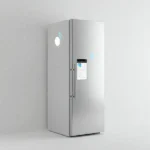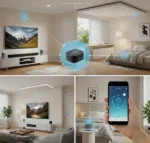Beyond the Thermostat: How Smart HVAC Systems are Revolutionizing Home Comfort and Efficiency
Gone are the days of the simple “on” and “off” thermostat. Today’s HVAC (Heating, Ventilation, and Air Conditioning) systems are undergoing a dramatic transformation, evolving into intelligent, interconnected networks that offer unprecedented levels of home comfort, energy efficiency, and control. This shift, driven by advancements in smart technology, is truly revolutionizing how we experience our indoor environments.
In this comprehensive guide, we’ll delve into the world of smart HVAC, exploring everything from intuitive smart thermostats to sophisticated zoning systems and advanced energy management capabilities. We’ll also examine how your iPhone and Android devices play a pivotal role in harnessing these innovations, looking at both built-in smart home apps and powerful third-party solutions.
The Brain of Your Smart Home: Smart Thermostats
At the heart of any smart HVAC system lies the smart thermostat. More than just a temperature dial, these devices are packed with features that learn your habits, respond to your commands, and actively work to save you money and energy.
Key Features of Smart Thermostats:
- Remote Control: Adjust your home’s temperature from anywhere in the world using your smartphone. Forgot to turn off the AC before leaving for vacation? No problem!
- Scheduling: Set personalized schedules for different times of the day and week, ensuring your home is always comfortable when you’re there and saving energy when you’re not.
- Learning Capabilities: Many smart thermostats, like the Google Nest Learning Thermostat, observe your preferences and build a schedule automatically, optimizing for comfort and efficiency without manual input.
- Geofencing: Some thermostats can detect when you’re leaving or arriving home via your phone’s location, automatically adjusting the temperature to save energy when you’re out and warm/cool the house before you return.
- Energy Reports: Gain insights into your energy consumption with detailed reports that highlight usage patterns and suggest ways to save.
- Voice Control: Seamlessly integrate with voice assistants like Amazon Alexa, Google Assistant, and Apple HomeKit (Siri) to adjust settings with simple voice commands.
- Sensor Integration: Connect with remote sensors to monitor temperatures in different rooms, addressing hot or cold spots and ensuring even comfort throughout your home.
- Air Quality Monitoring: Some advanced models include sensors to monitor indoor air quality, alerting you to pollutants and even integrating with smart air purifiers.
Smart Thermostat Features: A Comparative Look
This chart highlights key features across popular smart thermostat brands, including Google Nest, Ecobee, Honeywell Home, and Emerson Sensi. While specific models within each brand may vary, this table provides a general overview of common offerings.
| Feature | Google Nest Learning Thermostat (4th Gen) | Ecobee SmartThermostat Premium | Honeywell Home T9 Smart Thermostat | Emerson Sensi Touch Smart Thermostat |
| Core Functionality | ||||
| Remote Control (App) | Yes (Google Home App) | Yes (Ecobee App) | Yes (Honeywell Home App) | Yes (Sensi App) |
| Learning Schedule | Yes (Adapts to habits) | Yes (Eco+, learns/adapts) | No (Programmable schedules) | No (Programmable schedules) |
| Geofencing (Auto Home/Away) | Yes | Yes | Yes | Yes |
| Energy Usage Reports | Detailed in Google Home App | Detailed in Ecobee App | Yes, in Honeywell Home App | Yes, in Sensi App |
| Comfort & Control | ||||
| Remote Room Sensors | Included (1), supports more | Included (1), supports more | Included (1), supports up to 20 | Optional (supports internal/outdoor) |
| Prioritize Specific Rooms | Yes, with Nest Temperature Sensors | Yes, with SmartSensors | Yes, with Smart Room Sensors | No |
| Voice Control | Google Assistant, Alexa, Matter | Siri (built-in), Alexa, Google Assistant, SmartThings, IFTTT | Alexa, Google Assistant, SmartThings | Alexa, Google Assistant, HomeKit, SmartThings |
| Humidity Control (De/Humidifier) | Yes | Yes | Yes (with compatible HVAC) | Yes |
| Fan Control (Circulating) | Yes | Yes | Yes | Yes |
| Advanced Features | ||||
| Air Quality Monitoring | No | Yes (Built-in) | No | No |
| Built-in Speaker/Mic | No | Yes (for Siri/Alexa) | No | No |
| Smart Home Hub | Functions as a Google Home hub | Functions as a HomeKit hub (requires Apple Home hub for Siri) | No (integrates with hubs) | No (integrates with hubs) |
| Predictive Maintenance | Yes (System Health Monitor) | Yes (Alerts for issues) | Yes (Alerts for issues) | Yes (Smart Alerts for temp/humidity) |
| Filter Change Reminders | Yes | Yes | Yes | Yes |
| Vacation/Away Mode | Yes | Yes | Yes | Yes |
| Installation & Compatibility | ||||
| C-Wire Required | No (Power Sharing in most homes) | Yes (PEK included if needed) | Yes (Adapter included if needed) | Yes |
| HVAC System Compatibility | Most 24V systems (gas, electric, heat pump, etc.) | Most 24V systems | Most 24V systems | Most 24V systems (not baseboard heat) |
| Display Type | High-res color screen, Farsight | Color touchscreen, large display | Color graphical LCD touchscreen | HD color touchscreen |
Key to Understanding the Chart:
- Learning Schedule: This refers to the thermostat’s ability to observe your habits and automatically create or adjust a temperature schedule without manual programming.
- Remote Room Sensors: These wireless sensors can be placed in different rooms to provide more accurate temperature readings and help balance comfort across your home, addressing hot or cold spots.
- Prioritize Specific Rooms: This feature allows you to tell the thermostat to primarily focus on maintaining the desired temperature in certain rooms where sensors are placed, especially when those rooms are occupied.
- C-Wire Required: A “common wire” provides continuous power to the thermostat. Some smart thermostats can operate without it (using “power stealing” or internal batteries), but a C-wire generally ensures more stable performance and access to all features. Many brands include a “Power Extender Kit” (PEK) or C-wire adapter for homes without one.
- Smart Home Hub Functionality: Some smart thermostats can act as a central hub for other smart devices within their ecosystem, simplifying setup and control.
This comparison should help you identify which smart thermostat features are most important to you when making a purchasing decision for your home.
Targeted Comfort: HVAC Zoning Systems
Imagine being able to set different temperatures for different areas of your home. That’s the power of HVAC zoning. Instead of a single thermostat controlling the entire house, zoning divides your home into distinct areas (zones), each with its own temperature control.
Benefits of HVAC Zoning:
- Customized Comfort: Keep bedrooms cooler at night while maintaining a comfortable temperature in living areas during the day.
- Energy Savings: Avoid heating or cooling unoccupied rooms, leading to significant reductions in energy consumption and utility bills.
- Eliminate Hot/Cold Spots: Address common issues in multi-level homes or rooms with large windows where temperatures can fluctuate unevenly.
- Increased Efficiency: By only conditioning the areas that need it, your HVAC system works less, extending its lifespan.
Zoning systems typically involve a central control panel, multiple thermostats (one per zone), and automated dampers within your ductwork that open and close to direct airflow to the appropriate zones.
Intelligent Savings: Energy Management with Smart HVAC Systems
Beyond simply adjusting temperatures, smart HVAC systems are powerful tools for comprehensive energy management. They leverage data, automation, and intelligent algorithms to optimize energy consumption.
How Smart HVAC Enables Energy Management:
- Real-time Monitoring & Analytics: Track your energy usage in real-time and access detailed historical data to identify trends and potential areas for improvement.
- Automated Optimization: Based on factors like occupancy, external weather conditions, and even electricity pricing (in some regions), smart systems can automatically adjust settings for peak efficiency.
- Predictive Maintenance: By monitoring system performance and identifying anomalies, smart HVAC can alert you to potential issues before they become costly breakdowns, optimizing efficiency and extending equipment life.
- Integration with Smart Grids: In the future, smart HVAC systems will increasingly integrate with smart grids, allowing them to respond to demand-response programs and further optimize energy consumption during peak hours.
Your Pocket Command Center: iPhone and Android Apps
The true magic of smart HVAC lies in its accessibility and control, largely facilitated by dedicated smartphone applications. Whether you’re an iPhone enthusiast or an Android loyalist, a robust ecosystem of apps is available to manage your home comfort.
Built-in Smart HVAC Systems Home Apps:
Both Apple and Google offer their own integrated smart home platforms that can connect with various smart HVAC devices.
- Apple Home (iOS):
- Features: Apple HomeKit-enabled thermostats can be controlled directly from the Home app. This provides a centralized hub for all your HomeKit devices, allowing for seamless automation, scenes (e.g., “Good Morning” scene adjusts lights and thermostat), and Siri voice control.
- Pros: Tight integration with the Apple ecosystem, strong emphasis on privacy and security, intuitive interface.
- Cons: Limited to HomeKit-compatible devices, which might be fewer than other platforms for some specific HVAC components.
- Google Home (Android & iOS):
- Features: Google Home is the central app for Google Nest devices and many other smart home products that integrate with Google Assistant. You can control thermostats, set routines, view energy usage (for Nest thermostats), and use voice commands via Google Assistant.
- Pros: Broad compatibility with a vast range of smart home devices, powerful Google Assistant integration, user-friendly interface.
- Cons: Integration depth can vary between different third-party devices.
Third-Party Apps (Device-Specific & Universal Hubs):
Most smart thermostat and HVAC system manufacturers provide their own dedicated apps for their devices. These often offer the most in-depth control and unique features specific to their product.
- Manufacturer Apps (e.g., Ecobee App, Honeywell Home App, Carrier SmartHome App):
- Features: These apps provide comprehensive control over their respective thermostats and connected HVAC components. They often include advanced scheduling options, detailed energy reports, remote sensor management, and specific diagnostics or alerts related to the brand’s equipment.
- Pros: Full access to all device-specific features, optimized user experience for their own hardware.
- Cons: You might need multiple apps if you have devices from different manufacturers.
- Universal Smart Home Hub Apps (e.g., SmartThings, Hubitat Elevation, Home Assistant):
- Features: These apps act as central control points for a wide array of smart devices from different brands, including HVAC. They excel in creating complex automations and integrations between devices that might not natively communicate.
- Pros: Unifies control across many brands, powerful automation capabilities, often appeals to more tech-savvy users.
- Cons: Can have a steeper learning curve, may require a dedicated hub device.
Smart HVAC Systems Features Comparison Chart
Here’s a comparison of common features you’ll find across smart HVAC systems and their accompanying apps, noting general availability on iPhone and Android.
| Feature | Smart Thermostat App (General) | Apple Home App (iOS) | Google Home App (Android/iOS) | Third-Party Hub Apps (e.g., SmartThings) |
| Remote Temperature Control | Yes | Yes | Yes | Yes |
| Programmable Schedules | Yes | Yes (via scenes/automations) | Yes (via routines) | Yes |
| Learning Algorithms | Common (e.g., Nest, Ecobee) | N/A (thermostat-specific) | Yes (for Nest) | Yes (if supported by device) |
| Geofencing | Common | Yes | Yes | Yes |
| Energy Usage Reports | Common (detailed) | Limited | Yes (for Nest) | Yes (if supported by device) |
| Voice Control Integration | Yes (Alexa, Google, Siri) | Yes (Siri) | Yes (Google Assistant) | Yes (via integrated assistants) |
| Multi-Zone Control | Yes (with zoning system) | Yes | Yes | Yes |
| Remote Sensor Management | Common | Yes | Yes | Yes |
| Air Quality Monitoring | Some models | Limited | Limited | Yes (if supported by device) |
| Filter Change Reminders | Common | No | No | Yes (if supported by device) |
| Vacation Mode | Common | Yes | Yes | Yes |
| Smart Home Integration | Yes | Yes | Yes | Yes (core function) |
Note: “Common” indicates a feature widely available across many smart thermostat brands and their apps. “Limited” means basic functionality or only for specific integrated devices.
Additional Helpful Content:
- Professional Installation vs. DIY: While many smart thermostats are designed for DIY installation, especially if you’re just swapping out an old thermostat, more complex smart HVAC systems involving zoning or new ductwork often require professional installation. Consult with a certified HVAC technician to assess your specific needs and ensure proper setup.
- Compatibility Checks: Before purchasing any smart HVAC component, always double-check its compatibility with your existing HVAC system (e.g., C-wire requirement for some smart thermostats) and your preferred smart home ecosystem (Apple HomeKit, Google Home, Amazon Alexa).
- Security Considerations: As with any internet-connected device, ensure your smart HVAC system is secured. Use strong, unique passwords for your Wi-Fi network and smart home accounts, and keep your device firmware and apps updated.
- Long-Term Savings: While the initial investment in smart HVAC can be higher, the long-term energy savings and increased comfort often make it a worthwhile upgrade for many homeowners. Consider calculating your potential return on investment.
Troubleshooting Common Smart HVAC Systems
Even with advanced technology, issues can arise. Here are some common problems and troubleshooting tips:
- Thermostat Not Responding/Blank Screen:
- Check Power: Ensure your HVAC system has power. Check your circuit breaker for a tripped switch.
- C-Wire: Many smart thermostats require a “C-wire” (common wire) for continuous power. If your old thermostat didn’t have one, you might need to install one or use a power adapter (often included with the thermostat).
- Battery: If your smart thermostat uses batteries, check if they need replacement.
- Reset: Try resetting the thermostat according to the manufacturer’s instructions.
- No Heating or Cooling:
- Thermostat Mode: Ensure the thermostat is set to the correct mode (Heat, Cool, Auto) and the desired temperature is set appropriately.
- Fan Setting: Check if the fan is set to “Auto” or “On.” If it’s on “On,” the fan will run continuously even if the system isn’t actively heating or cooling.
- Clogged Air Filter: A dirty air filter can restrict airflow and cause your system to malfunction or become inefficient. Replace or clean it regularly.
- Outdoor Unit Issues: Ensure the outdoor unit (for AC/heat pump) is clear of debris and has proper airflow.
- Uneven Temperatures (Hot/Cold Spots):
- Zoning System Check: If you have a zoning system, ensure each zone’s thermostat is set correctly and the dampers are functioning properly.
- Remote Sensors: If using remote sensors, ensure they are placed optimally and connected to your smart thermostat.
- Ductwork Leaks: Leaky or uninsulated ductwork can lead to significant temperature inconsistencies. Consider having your ductwork inspected.
- Wi-Fi Connectivity Issues:
- Router Distance/Interference: Ensure your smart thermostat is within range of your Wi-Fi router and there’s no major interference from other electronic devices.
- Router Reboot: Try rebooting your Wi-Fi router.
- Network Compatibility: Some older smart thermostats may only support 2.4 GHz Wi-Fi networks. Check your router settings.
- App Not Connecting/Responding:
- Internet Connection: Verify your phone has a stable internet connection.
- App Updates: Ensure your smart HVAC app is updated to the latest version.
- Thermostat Online: Check if your thermostat itself is showing as online in the app or on the device’s display.
- Re-link Account: Sometimes unlinking and relinking your thermostat account within the app can resolve connection issues.
Frequently Asked Questions (FAQ)
Q1: Is a smart thermostat worth the investment? A1: For most homeowners, yes. While there’s an initial cost, the energy savings from optimized scheduling, learning capabilities, and remote control can lead to significant long-term savings on utility bills. The added convenience and comfort are also major benefits.
Q2: Can I install a smart thermostat myself? A2: Many smart thermostats are designed for DIY installation, especially if you’re replacing a standard thermostat and have a C-wire. However, if you’re unsure about wiring, or if your system requires a C-wire adapter, it’s always best to consult with a qualified HVAC technician.
Q3: Do smart HVAC systems work with older homes? A3: In many cases, yes. Smart thermostats are generally compatible with most standard HVAC systems. However, installing a full zoning system in an older home might require ductwork modifications, which would need professional assessment.
Q4: How much energy can I save with a smart HVAC system? A4: Savings vary depending on factors like your climate, home insulation, personal habits, and the features of your smart system. However, studies and real-world data suggest savings of 10-20% or even more on heating and cooling costs are achievable.
Q5: What’s the difference between a smart thermostat and a programmable thermostat? A5: A programmable thermostat allows you to set a schedule, but it’s static. A smart thermostat goes further by learning your habits, using geofencing, integrating with other smart devices, providing energy insights, and offering remote control, making it much more dynamic and efficient.
Q6: Are smart HVAC systems secure from hacking? A6: Reputable manufacturers prioritize security, but like any internet-connected device, vulnerabilities can exist. It’s crucial to use strong passwords, enable two-factor authentication if available, and keep your device firmware and apps updated to the latest versions.
Additional helpful information
A smart HVAC system should use a good Smart Home Ecosystem – Smart Home Ecosystems: HomeKit vs. Google Home vs. Alexa
More information about smart thermostats – Smart Thermostats and Climate Control
External Links for Authoritative Sources:
- U.S. Department of Energy – Smart Thermostats: https://www.energy.gov/energysaver/smart-thermostats
- Investopedia – Smart Home Definition & Benefits: https://www.investopedia.com/terms/s/smart-home.asp
- Trane – AC Zoning Explained: https://www.trane.com/residential/en/resources/blog/zoned-hvac-system/
- Google Nest Support: https://support.google.com/nest/
- Apple HomeKit: https://www.apple.com/ios/home/




